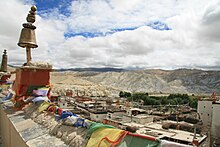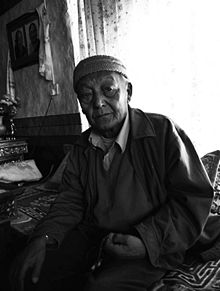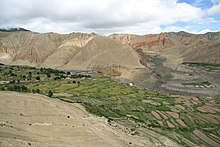Mustang (Kingdom)
Mustang (also Mustan ) was an independent Buddhist kingdom in the Himalayas . Today it belongs to Nepal and forms the northern part of the Nepalese district of Mustang . The name is of Nepalese origin. In the local language the country is called Lo (south).
Geography and climate
Mustang lies between the Nepalese districts of Dolpo , Myagdi and Manang and borders on Tibet . The area is 2,563 km² and lies at an altitude of over 2,500 meters north of the Annapurna massif. Due to its location in the rain shadow of the surrounding mountains, it is climatically dry. The annual rainfall is around 250–400 mm.
The country is shaped by the Kali Gandaki river , its valley and its tributaries. The river runs from northeast to southwest towards the Nepal Terai , dividing the area. The river was once the main trade route between Tibet and India , especially for salt . The river valley runs through Thak Khola , the deepest canyon in the world. The traditional capital of the kingdom is Lo Manthang . The administrative center of the entire district is Jomosom , which has had an airfield since 1962 and has developed into the main tourist destination since the district was opened.
The entire Mustang area is under special state protection. Since 1992 Lo Manthang has been one of the seven unit conservation offices in the Annapurna Conservation Area Project (ACAP), the oldest and largest protected area in Nepal. The project aims to promote nature conservation and at the same time improve the situation of the population, with different priorities in each region. In Mustang, in particular, controlled tourism is to be developed, the cultural heritage protected and alternative energies promoted. ACAP is not without controversy among the population; Criticism is particularly leveled at the sluggish bureaucratic decision-making processes; there are also allegations of nepotism.
history
Mustang was once an independent kingdom founded around 1400 by the legendary warrior Ame Pal . It was closely linked to Tibet through language and culture. At the end of the 18th century, the empire was annexed by Nepal, but remained a domestically autonomous territory within the Nepalese state until the middle of the 20th century. After the occupation of Tibet by China and the collapse of the trade routes, the country completely lost its independence and has since been incorporated into the administrative structure of Nepal as the northern part of the Mustang district. The monarchy lived on as the Kingdom of Lo until the summer of 2008, but the current Nepalese government has dissolved the tradition of the Rajas in Nepal. The former Raja or king (in the local language Gyelpo ) Jigme Palbar Bista traced his ancestry back to the founder of the empire Ame Pal, traditionally in the 25th generation. He continued to enjoy a high reputation among the population.
Tibetan resistance fighters stayed in the Mustang until 1974. The area was therefore closed to travelers. The southern part of the district could not be entered until the 1970s, the Kingdom of Lo until 1992, with a few exceptions. A permit is still required to visit the former kingdom today.
population
The name for the country dwellers of Lo is Lopa . They are linguistically and culturally related to the Tibetans . The language called Lowa or Lop is a Tibetan dialect . It is spoken by 7,500 people. Other Tibetan dialects and Nepali are also in use.
The population of around 6,000 people lives in 32 settlements. Most of them live near the Kali Gandaki River . The harsh conditions due to the high location, however, result in a seasonal migration of the inhabitants to the lower regions of Nepal.
religion
Mustang residents are Buddhists . The predominant Tibetan Buddhist schools are the Nyingma and Sakya schools . The country has a very old Buddhist tradition. The first meditation center (Tib. Gompa ) was founded 2000 years ago . The subsequent Buddhist movement reached Mustang with the great Indian Buddhist master Padmasambhava in the 8th century. He founded the Nyingma School. A little later, in the 11th century, the Sakya School was transferred to Mustang. Former King Jigme Palbar Bista was seen as an emanation from Bodhisattva Manjushri .
In general, more and more lamas and monks have left Mustang over the centuries . More monasteries are currently being founded again, for example in Geling, Tsarang, Lo Manthang and Namgyal. During the renovation of the monasteries, the population actively participated as trained painters under the guidance of Italian restorers.
As everywhere in the Buddhist regions of the Himalayas, the Lopas write their wishes for the ultimate happiness and well-being of all beings on colored prayer flags , which represent the five Buddha families and are carried into the world with the wind.
economy
Mustang traditionally obtained a large part of its income from the salt trade on the transit route between China and India, which runs in the river valley of the Kali Gandaki. After the occupation of Tibet by China, trade routes collapsed and the standard of living fell continuously. The most important branches of the economy are agriculture, tourism has been added since the 1990s. In winter, however, 50% of the population migrate south in search of employment opportunities.
Because of the drought, arable farming is dependent on irrigation systems. Are grown buckwheat and barley , in climatically favorable regions of vegetables and fruits are added. The growing season lasts from May to September. However, for five months a year the ground is covered in snow. Two harvests per year can be brought in in the south and only one in the north. Cattle breeding has declined sharply since farmers can no longer drive their herds to the fertile pastures on the other side of the Tibetan border. The main farm animals are the yaks , water buffalo , sheep and goats .
Since 2001 there has been an unpaved road connection between Lo Manthang and Tibet. However, the Nepalese-Chinese border is only opened approximately twice a year for Tibetan traders to cross the border. From 2009 there is now a connection between Lo Manthang and Jomosom, which can be used by jeeps and other all-terrain vehicles. The street is changing the economic framework and people's living conditions significantly. The prices for imported goods such as fuel and rice have fallen sharply, and the dependence on food imports is increasing.
literature
- Dhungel, Ramesh: The kingdom of Lo (Mustang). A historical study. Kathmandu, Tashi Gephel Foundation, 2002. ISBN 99933-5793-6
- Michel Peissel : Mustang - A lost Tibetan Kingdom . Dutton, New York 1967 ( limited preview in the Google book search) (German: The Forbidden Kingdom in the Himalayas. Fischer, Frankfurt 1978, ISBN 3-596-23501-4 ).
Documentaries
- Steve Chao: Mustang: A Kingdom on the Edge . Al Jazeera Correspondent , February 20, 2012 (video, English, 47 min.)
- Himalaya - Empire of the Windhorse - Part 3 Mustang (Part 1 Ladakh , Part 2 Spiti ). TV documentary by Hajo Bermann from 2011.
Web links
- Geographical Field Studies in Southern Mustang / Kali Gandaki Valley (University of Gießen) ( Memento from November 26, 2013 in the Internet Archive )
- School Association Lo Manthang
- Sustainable development plan for MUSTANG 2008-2013 (National Trust for Nature Conservation)
- Tibetan Buddhist Wall Paintings of Mustang (a photographic survey, Philip and Marcia R. Lieberman)
Remarks
- ↑ http://geb.uni-giessen.de/geb/volltexte/2007/4664/pdf/PeterAnnapurna_Werkstatt_12_1-21.pdf
- ↑ The official lineage is being questioned in favor of a descent from a Gurkha prince of the late 18th century. Cf. Michael Beck: Mustang - In the Land of Lo-pa, p. 99
- ↑ http://www.ethnologue.com/show_language.asp?code=loy
- ↑ Mustang, the gateway to heaven in the Himalayas . Retrieved October 14, 2013.
Coordinates: 29 ° N , 84 ° E






